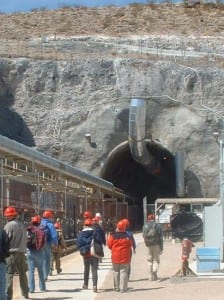Will GOP’s Wave Revive Yucca Mountain?
The crash of the Democrats in the U.S. Senate following this month’s elections and the unseating of Sen. Harry Reid of Nevada as majority leader has supporters of the Department of Energy’s stagnant Yucca Mountain storage site for spent civilian nuclear fuel singing “Happy Days Are Here Again.” Is the refrain premature?
Former Democratic Sen. J. Bennett Johnston of Louisiana orchestrated the “Screw Nevada” plan in 1987 that mandated the federal land at Yucca Mountain in the Nevada nuclear weapons test site as the cemetery for high-level nuclear waste. He told the Platts TV show just after the recent election, “Yucca Mountain is not dead yet. It is sleeping. It is moribund but eventually it gets approved somehow. I think Congress would want to do that.”
Many Republicans have used Yucca Mountain to spar with Democrats on energy policy. The GOP has highlighted the hometown opposition of Reid and his alliance with the Obama White House to kill the project, arguing that the Democrats’ opposition to the site has no technical basis. Fueling those objections to the administration, the Nuclear Regulatory Commission recently found that the DOE plan for the waste dump is safe. The New York Times, with a bit of hyperbole, headlined a straightforward report of the NRC action, “Calls to Use Yucca Mountain as a Nuclear Waste Site, Now Deemed Safe.”
The newspaper account prompted Rep. John Shimkus (R-Ill.), chairman of the House Energy and Commerce Committee’s environment and the economy subcommittee, to comment that the report “confirms what we’ve expected all along: nuclear waste storage under that mountain, in that desert, surrounded by federal land, will be safe and secure for at least a million years.”

That partisan optimism prompted former NRC commissioner Victor Gilinsky, a Democrat and physicist who advised the state of Nevada, to comment in The Bulletin of the Atomic Scientists that the “hosannas are premature. The NRC staff did not explain, and no one in the media seems to have caught on, that its favorable conclusion reflected the Energy Department’s pie-in-the-sky design for Yucca Mountain – not the repository as it is likely to be reconfigured. The likely repository reconfiguration doesn’t come close to meeting NRC requirements.”
The key issue is groundwater. One reason Congress decided to mandate the repository at Yucca Mountain, short-circuiting a politically-fraught multiple-site inquiry in the 1982 Nuclear Waste Policy Act, was the assumption that the rock strata deep under Yucca Mountain were dry. Water is the bane of storage of nasty stuff. It provides a pathway for the nasty stuff to move off the site.
That assumption didn’t hold up. My book – “Too Dumb to Meter: Follies, Fiascoes, Dead Ends and Duds on the U.S. Road to Atomic Energy” – describes how Gilinsky in 2002 did an underground tour of the Yucca Mountain project. He told a Congressional committee that he was pretty surprised “to find myself standing in the middle of this mountain with water dripping out and hitting me on the head.”
The unexpected water at Yucca Mountain forced a major redesign of the project, including metal canisters for the waste and titanium “drip shields” to prevent water from hitting the metal canisters. DOE says it will install the shields after a hundred years of Yucca Mountain operations. Placing the shields in the Yucca Mountain tunnels after the waste is there, says Gilinsky, would be expensive and complex, requiring use of robotic technology. He predicts that “a century into the project, the underground tunnels would have deteriorated and collapsed in part. Dust would sharply limit visibility.” A host of other technological hurdles would arise.
Says Gilinsky, casting doubt on the credibility of DOE, “Can we really rely on an agency that hasn’t yet cleaned up a nationwide mess that dates from World War II to keep a promise that it will do something a century into the future? Will there even be an Energy Department in 100 years?” Those questions could frame the debate if supporters of Yucca Mountain seek to revive the project.